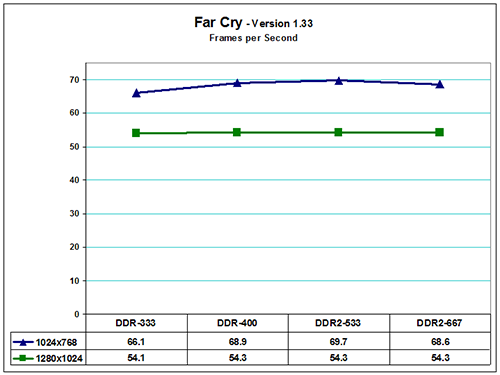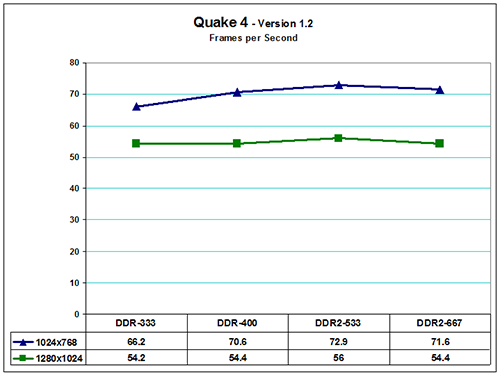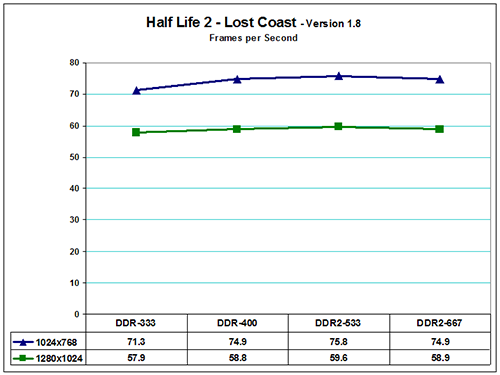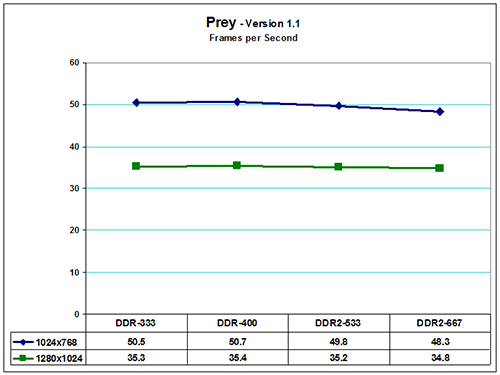ASRock 775Dual-VSTA: Does DDR2 matter?
by Gary Key on August 8, 2006 6:35 AM EST- Posted in
- Motherboards
Game Performance Comparison
While Sandra and Super Pi provide useful information on how memory performs without the influence of other components, our first round of real world tests has shown there is not a large difference in performance between DDR2 and DDR memory on this particular platform. However, our next set of real-world benchmarks consists of gaming benchmarks.
We utilize Far Cry, Half-Life 2 and Quake 4 in our normal memory testing because they are sensitive to memory changes. We are adding Prey and Serious Sam II to our benchmark mix because they are typically very GPU dependent and we will see the effects of our memory choices on these games. We tested at both 1024x768 and 1280x1024 at High Quality settings but without anti-aliasing or antistrophic filtering enabled. We feel like these settings are representative of a platform at this price point and believe most users would be utilizing a 17" or 19" monitor with this setup.





Our three memory sensitive games show a slight difference in results at 1024x768 but are GPU limited at 1280x1024 for all intents and purposes. The performance pattern is similar to the synthetic benchmarks with the DDR2-533 setting performing best overall. The DDR2-667 and DDR-400 configurations basically end in a tie with the DDR-333 finishing last. Our two GPU limited games actually favor the DDR-400 memory setup although the scores across the board are well within our margin of test error.
Overall, gaming performance is fine with low latency DDR-400 memory on this platform. Even DDR-333 provides for acceptable performance, particularly if you're looking to upgrade from an old socket A or 478 system. In that case, you might also want a new GPU, but we'll take a look at PCIe vs. AGP performance in part two of this series.
While Sandra and Super Pi provide useful information on how memory performs without the influence of other components, our first round of real world tests has shown there is not a large difference in performance between DDR2 and DDR memory on this particular platform. However, our next set of real-world benchmarks consists of gaming benchmarks.
We utilize Far Cry, Half-Life 2 and Quake 4 in our normal memory testing because they are sensitive to memory changes. We are adding Prey and Serious Sam II to our benchmark mix because they are typically very GPU dependent and we will see the effects of our memory choices on these games. We tested at both 1024x768 and 1280x1024 at High Quality settings but without anti-aliasing or antistrophic filtering enabled. We feel like these settings are representative of a platform at this price point and believe most users would be utilizing a 17" or 19" monitor with this setup.





Our three memory sensitive games show a slight difference in results at 1024x768 but are GPU limited at 1280x1024 for all intents and purposes. The performance pattern is similar to the synthetic benchmarks with the DDR2-533 setting performing best overall. The DDR2-667 and DDR-400 configurations basically end in a tie with the DDR-333 finishing last. Our two GPU limited games actually favor the DDR-400 memory setup although the scores across the board are well within our margin of test error.
Overall, gaming performance is fine with low latency DDR-400 memory on this platform. Even DDR-333 provides for acceptable performance, particularly if you're looking to upgrade from an old socket A or 478 system. In that case, you might also want a new GPU, but we'll take a look at PCIe vs. AGP performance in part two of this series.










55 Comments
View All Comments
Sunrise089 - Wednesday, August 9, 2006 - link
From the link you provided:"The 4MB L2 cache can increase performance by as much as 10% in some situations. Such a performance improvement is definitely tangible, and as applications grow larger in their working data sets then the advantage of a larger cache will only become more visible. "
Also keep in mind a 3.5% average is much like claiming a new GPU is unnecessary because it only effect's your computing experience 10% of the time. If it's effects are highly pronoumced during those times it could still be worthwhile. The 4meg parts have a 10% inprovement in some apps and games, and that is a pretty big deal.
Paladin165 - Wednesday, August 9, 2006 - link
cmon man, get real. I would never buy a new GPU if it only offered a 10% increase. Also, the big increases are in DIVX compression, itunes, content creation, etc. Most of the game benchmarks are around 1%. In fact the 5% oblivion dungeon benchmark is a little hard for me to beleive, as oblivion shows virtually no gain from extra cache in other tests (http://www.anandtech.com/cpuchipsets/showdoc.aspx?...">http://www.anandtech.com/cpuchipsets/showdoc.aspx?.... The only game that shows a substaintial increase is Quake at 6.7%.The situation is in fact the opposite of a GPU. The GPU increases your performance during the "10% of the time" when it counts, during games. The extra cache on the Conroe seems to increase performance when it doesn't count.
For the record, I agree with you about AMD carrying the better budget offerings at present. Intel has only the ASrock board to offer the budget gamer, which comes with some big sacrafices (lack of overclocking, 4XPCI-E). However, I am buying this board so that I can afford a better core 2 processor (6400 or 6600), which I will put in a better budget motherboard in a few months. I figure I'm basically "renting" this motherboard for 6 months or so. So I think going with budget conroe offers a much better upgrade path. Once we have cheap boards that can overclock the 6300/6400 30-40% (which should happen in only a month or two) your argument will be obselete because the overclocked Allendales absolutely crush the X2 chips.
Sunrise089 - Wednesday, August 9, 2006 - link
"Once we have cheap boards that can overclock the 6300/6400 30-40% (which should happen in only a month or two) your argument will be obselete because the overclocked Allendales absolutely crush the X2 chips."That's true, and I look forward to it. I just think AMD has spoiled me with the idea that there is very little reason to spend extra $$$ so long as I'm willing to work a bit and accept some risk. If Intel prices move a bit to make the same situation true, I will be happily enjoying my fast Conroe machine.
araczynski - Tuesday, August 8, 2006 - link
wow, thanks for a great article, something actually applicable to the real world ;)looking forward to the next parts. although I'm still going for an e6600 with a highly overclockable mobo (probably the asus pdxyzdeluxesomethingorother), its good to see things in perspective.
johnsonx - Tuesday, August 8, 2006 - link
I don't normally join the ranks of the review bashers (who of course mostly come out of the woodwork when Intel is reviewed favorably against AMD), but this review seems to have a fatal flaw.The stated purpose is to show what you do or don't gain by trading in your DDR memory when moving to a Core 2 Duo platform. The review compares DDR to DDR2 performance on the same platform, which at first glance seems reasonable. However, in the prior review of another mainboard based on the same PT880Pro chipset (the review linked at the bottom of page 3), your conclusion about that board states:
The charts in that review show that BOTH DDR and DDR2 performance was equally dismal.
Since the primary reason for purchasing this board is for DDR support, presumably no one who wants to upgrade to DDR2 would bother with it. Therefore any performance comparison of DDR to DDR2 on this board is pointless for the stated purpose of the article. It artificially cripples DDR2 performance, making DDR look quite good and even superior.
For a proper comparison, you need a reasonably priced competitor that doesn't suffer such low DDR2 performance; perhaps a P965Express board, or even a 945 board if any of those have Conroe support.
Gary Key - Wednesday, August 9, 2006 - link
Our comments were based on the performance at the time of review with an early but shipping bios revision that as it turns out had some memory timing issues. The latest bios (1.5) has altered the performance of this board to some degree although DDR2-667 performance is not where it should be. In some cases the performance differences are less than 5% now when using optimized DDR2-533 settings. While this board does not have the overclocking capability of the P965 boards we have tested to date, it still performs within reason at stock speeds.
You are correct. However, we did state (first page) that a full comparsion would be provided in our final article. While I wanted to post a P965 result in this article we had not received our "budget" P965 boards from Foxconn, Epox, ECS, or MSI yet (two are here now, other two next week). I felt like a comparison to a 965 board that will be in the $100 price range would be better than showing results against a $150~$225 P965 board. Also, ASRock had just provided a new bios update (memory compatibility) for the 945P and 945PL boards that we are still testing as of today. It appears at first glance our original memory performance issues with these boards have been solved also. It appears now that the VIA memory performance at DDR2-533 is within 5% of our better performing P965 boards. We will have a full comparison up next week and hopefully we can figure out a way to get DDR2-667 working at CAS3 in a stable manner (it works but we still have not completed a full round of testing without a failure, BF2 and Q4 seem the most sensitive to lockup but SuperPI passes, LOL).
I appreciate your comments and look forward to your thoughts on the final article.
NeverGuy - Thursday, August 10, 2006 - link
IS this board basically the same as the ASUS P5VDC-X that is selling for about the same price? Would the ASUS board have CPU voltage adjustment?Gary Key - Thursday, August 10, 2006 - link
Close to the same, the main difference is the Asus version does not support Core 2 Duo but does offer slightly better overclocking options.
johnsonx - Wednesday, August 9, 2006 - link
Yep, I didn't see that line. You have to admit though it's buried pretty deep in that paragraph. I still think THIS article would have been far more informative with 1 other value DDR2 comparison point. But the whole picture will be clear with the final article, so I'll just look forward to that.
On a side note, I'm quite interested in this series of articles, yet I have almost zero interest in actually buying any Core 2 products for myself or for customers. Aside from the occaisional high power 3D CAD box (for running ProE usually), I travel exclusively in the budget and low-midrange market. Intel hasn't had anything compelling for me there in years, and still doesn't. I guess Core 2 info is more interesting than AM2 info, even if I'm not going to buy it.
Calin - Wednesday, August 9, 2006 - link
In reviews here, I saw a tendency to use grand words for small feats. I won't consider the 10% this board is behind others "dismal performance" - so for very little money, you could get good performance - that is the thing every budget buyer wants.